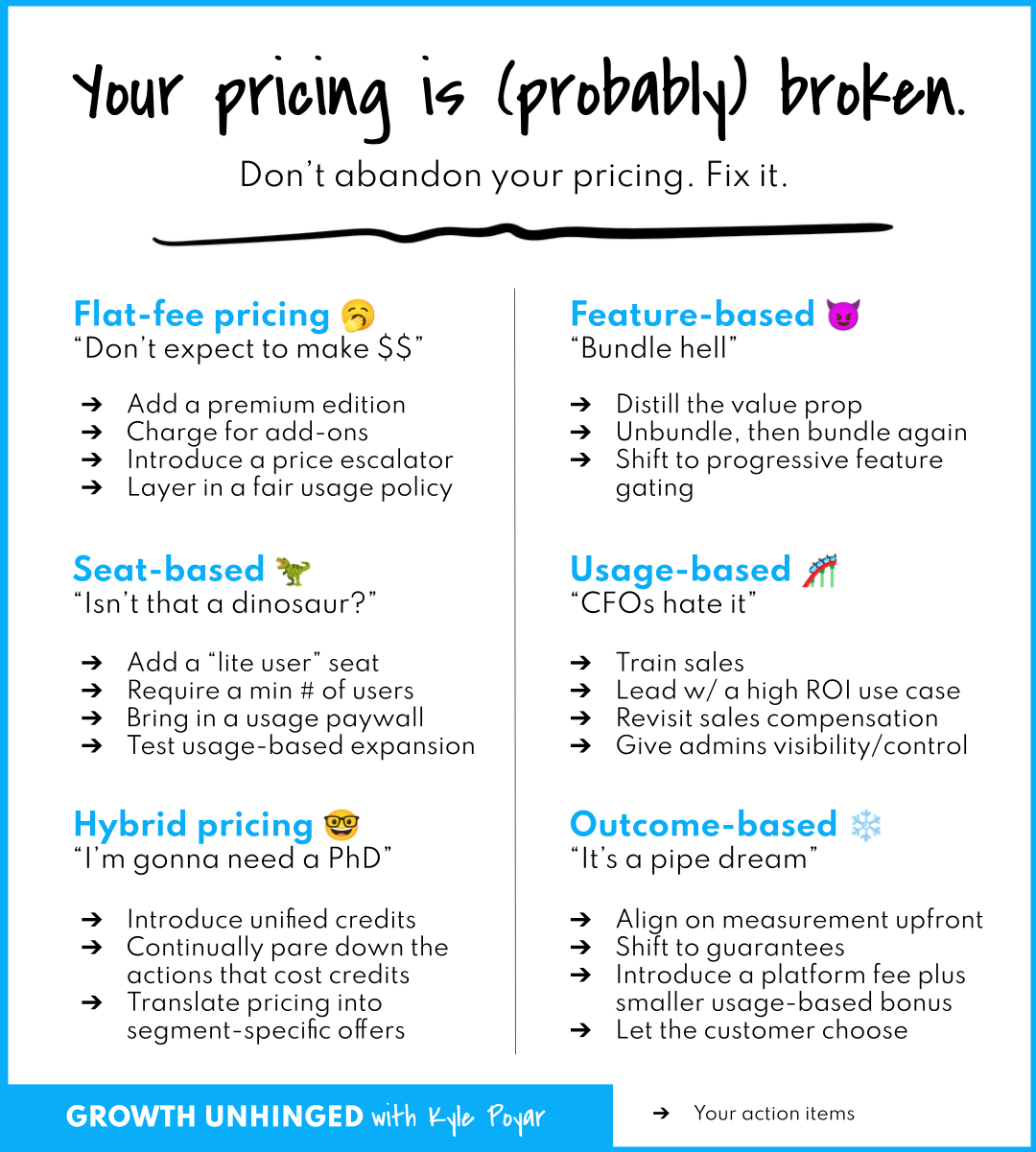Your pricing is (probably) broken
Why there's no such thing as a perfect pricing model

a16z General Partner Martin Casado is a legend in the world of investing, serving on Boards of iconic companies like Ambient.ai, Astranis, Cursor, dbt Labs, Fivetran and Kong. Martin has a first-hand look into how the best AI companies are monetizing their products for breakout growth. Now he’ll be sharing how AI is rewriting the rules of SaaS monetization. Save your spot for Martin’s webinar with Metronome on November 4th.
Your pricing is (probably) broken
In just the past few weeks I’ve met with three dozen software founders, and the topic of pricing and packaging inevitably came up in nearly every conversation. The businesses included mature SaaS companies, next-gen vertical SaaS plays, and breakout AI-native startups.
What struck me was how many founders seem embarrassed about their pricing. They know it hasn’t been optimized. Their VCs tell them they should be charging more. And they wonder if they’re a dinosaur because they haven’t shifted to a newer pricing model like credits or outcome-based pricing.
I’m here to tell you: yes, your pricing is (probably) broken. And that’s OK!
Today I’ll be roasting your pricing. And I’m offering tactical action items to make the most of your existing model — because, frankly, it’ll never be perfect.
👋 Hi, it’s Kyle Poyar and welcome to Growth Unhinged, my weekly newsletter exploring the hidden playbooks behind the fastest-growing startups.
ICYMI: 🎧 Mostly Growth podcast | The odds of making it | Turn ChatGPT into pipeline
1. Flat-fee subscriptions (“Don’t expect to make $$”)
Customers will tell you they want a flat-fee subscription, also known as an unlimited plan. It’s predictable. It’s simple. There are no surprise bills.
What customers ask for isn’t necessarily best for running a profitable business. Why it might be broken:
Small companies get priced out
Large companies pay too little
There’s no expansion revenue
High potential for low/negative margin customers
Your action item is to find two or more levers to expand your best customers. Here are four places to start:
Add a premium edition at a higher price point. This is typically priced at 50-100% more than the base edition and you can reasonably expect 15-25% uptake. (That’s +15% revenue across your customer base.)
Charge for add-ons that most folks don’t need (but some really value). Add-ons are usually priced at 10-30% of the core product price. (Adoption varies significantly.)
Introduce a price escalator clause. As I wrote last year, 1-in-3 B2B contracts includes an automatic price increase in their auto-renewals. These are generally between 5-8% on an annual agreement. Many large customers expect (and budget for) them.
Layer in a fair usage policy for your top 10% of power users. In my experience, 70-80% of AI token consumption comes from just 10% of users.
2. Feature-based pricing (“Bundle hell”)
Nearly every SaaS company got the memo that they should have about three paid plans, also known as Good-Better-Best packages. You can find this style of packaging at Salesforce, Figma, Airtable, Miro, Slack, Notion, and (almost) everywhere else.
This is generally a safe bet, but it’s not without its flaws. Why it might be broken:
Almost everyone defaults to the middle tier
The plans feel arbitrary and confusing
Everyone wants to pick-and-choose to create their own package
Each new feature throws your plans into a tailspin
Your action item is to make it obvious who each plan is for and why they should buy it. Here are three action items:
Distill the value proposition of each package down to one sentence or less.
Unbundle, then bundle again. Launch 1-2 new features per year as standalone add-ons. Then bundle these into packages (at higher price points) roughly once every 18 months to maintain simplicity.
Shift to progressive feature gating (see Amplitude, ClickUp) to offer a taste of premium features across all plans. This gives customers a taste of higher tier plans before they upgrade.
3. Seat-based pricing (“Isn’t that a dinosaur?”)
While there has been a real shift toward more flexible and usage-based pricing models, the reality is that seats remain an important part of the monetization mix. Seats aren’t necessarily dying, but it’s clear they’re less effective than they used to be:
Companies are reducing headcount with AI, meaning less seat $$ over time
The value of AI agents doesn’t scale naturally with buying more seats
Not all users are the same. Why should they pay the same for a seat?
Seats put an artificial cap on the potential $$ of an account
If seats are a major source of your revenue, I’ll be the first to tell you that it can be exceptionally difficult to abandon them. But you can redefine them. Here are four action items:
Add a “lite user” seat for more occasional users. Figma does something similar; so does Tableau. Lite user pricing ranges anywhere from 10-40% the price of a power user. (Some companies sell unlimited lite users as a feature, too, which reduces the admin burden of managing multiple license types.)
Require a minimum number of users for certain plans. Canva now does this as part of their Team pricing, all while communicating the Team plan as less expensive per person compared to Canva Pro.
Bring in a usage paywall. SurveyMonkey did this with survey response limits across paid plans. More expensive plans include more survey responses (along with more features), albeit at a higher price per seat.
Test a usage model as an expansion play for larger Enterprise customers. Many companies I talk to are hesitant to fully pivot from seat-based to usage-based pricing. But they’ll pilot a usage-based model as a way to increase penetration and share-of-wallet with select existing customers. This is de-risked on both sides since there’s past usage data as a baseline.
Keep reading with a 7-day free trial
Subscribe to Kyle Poyar’s Growth Unhinged to keep reading this post and get 7 days of free access to the full post archives.




